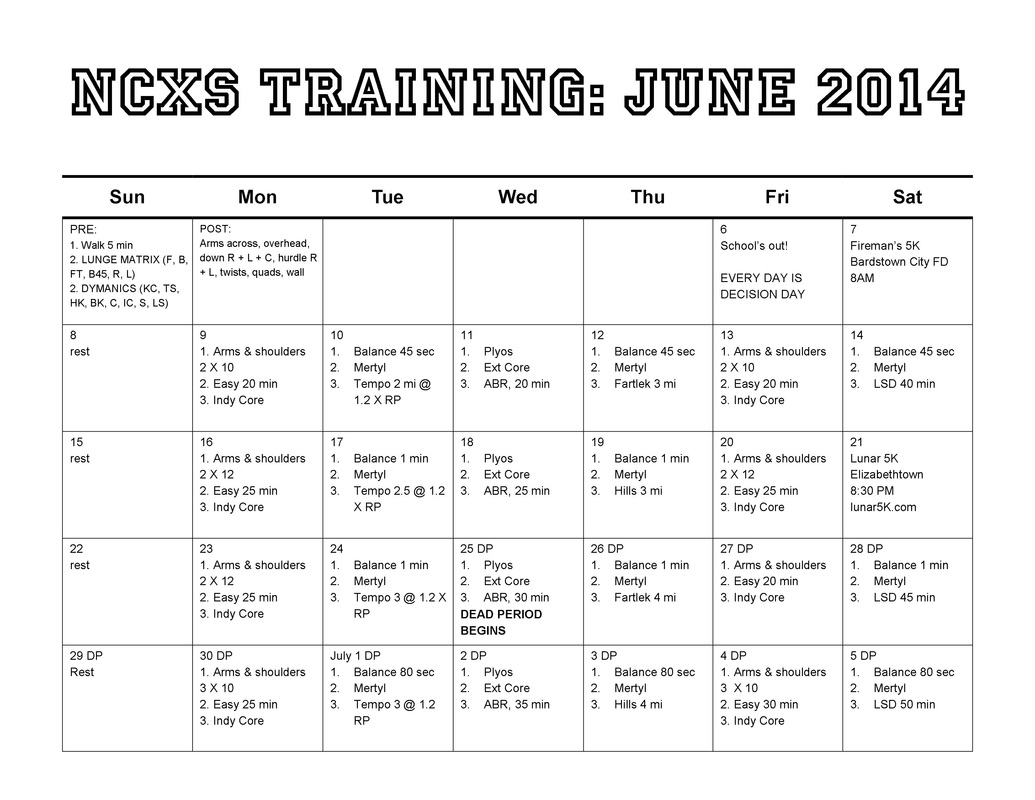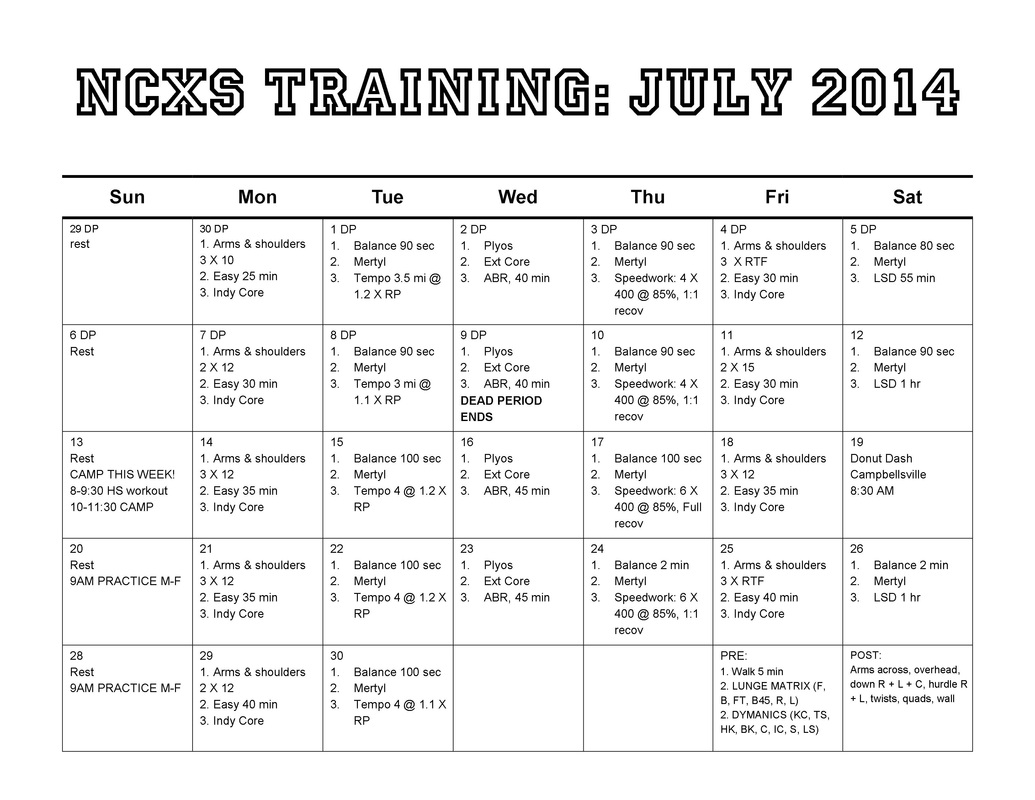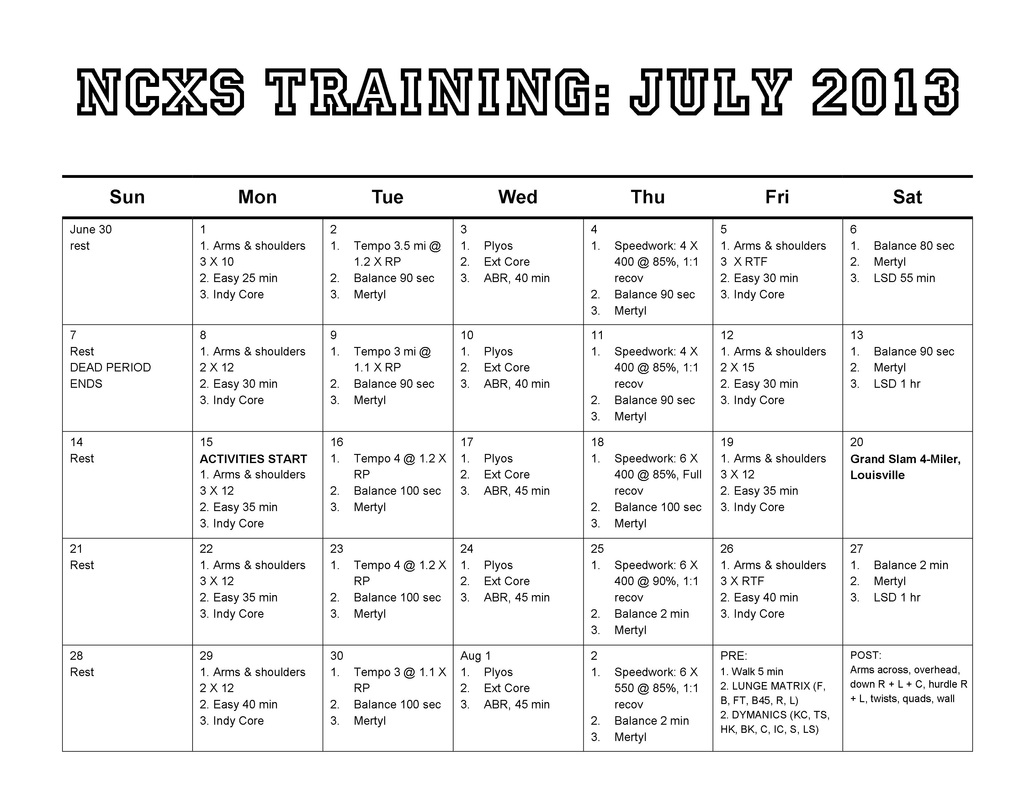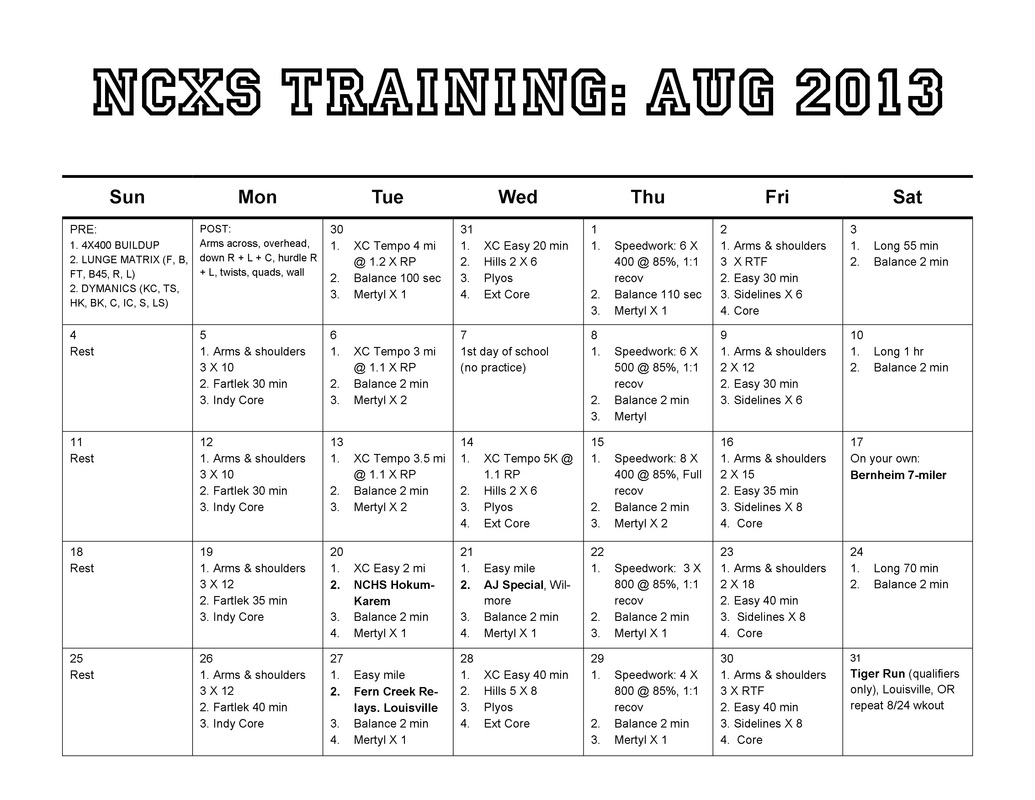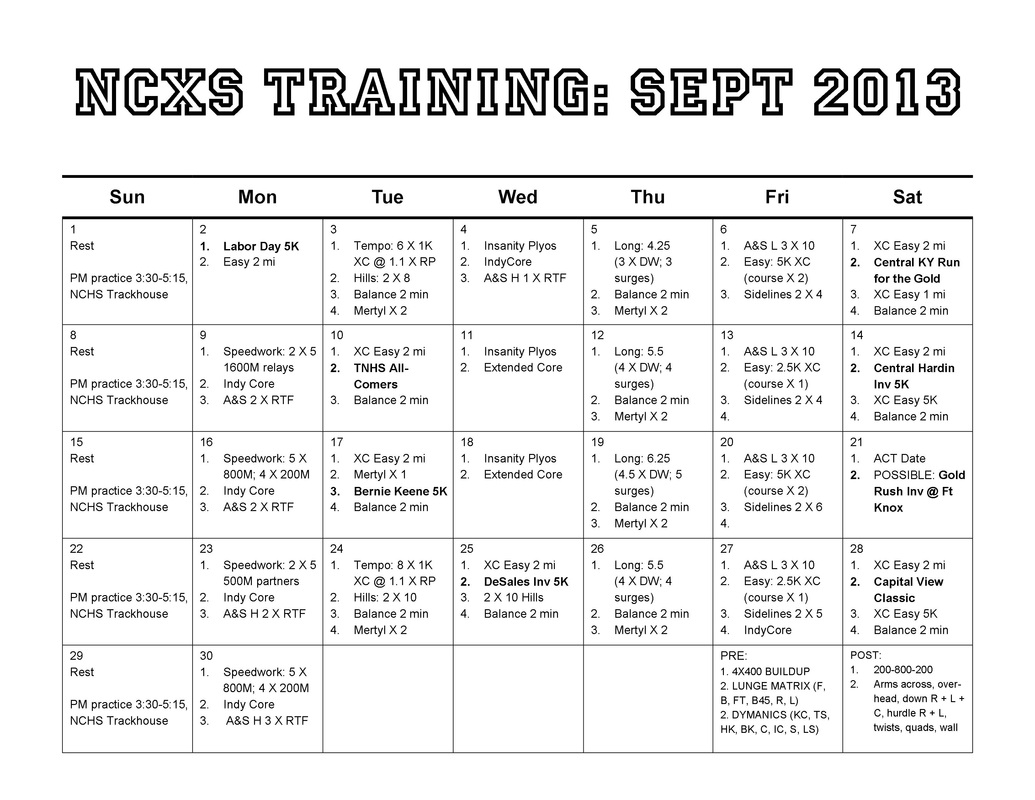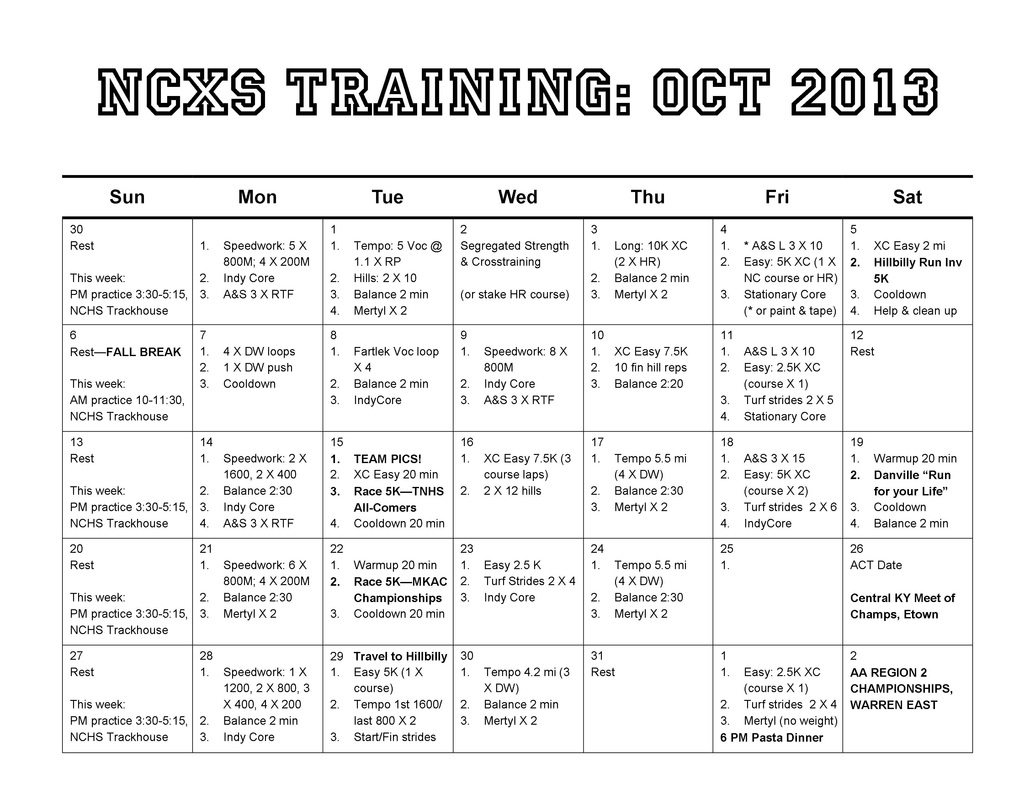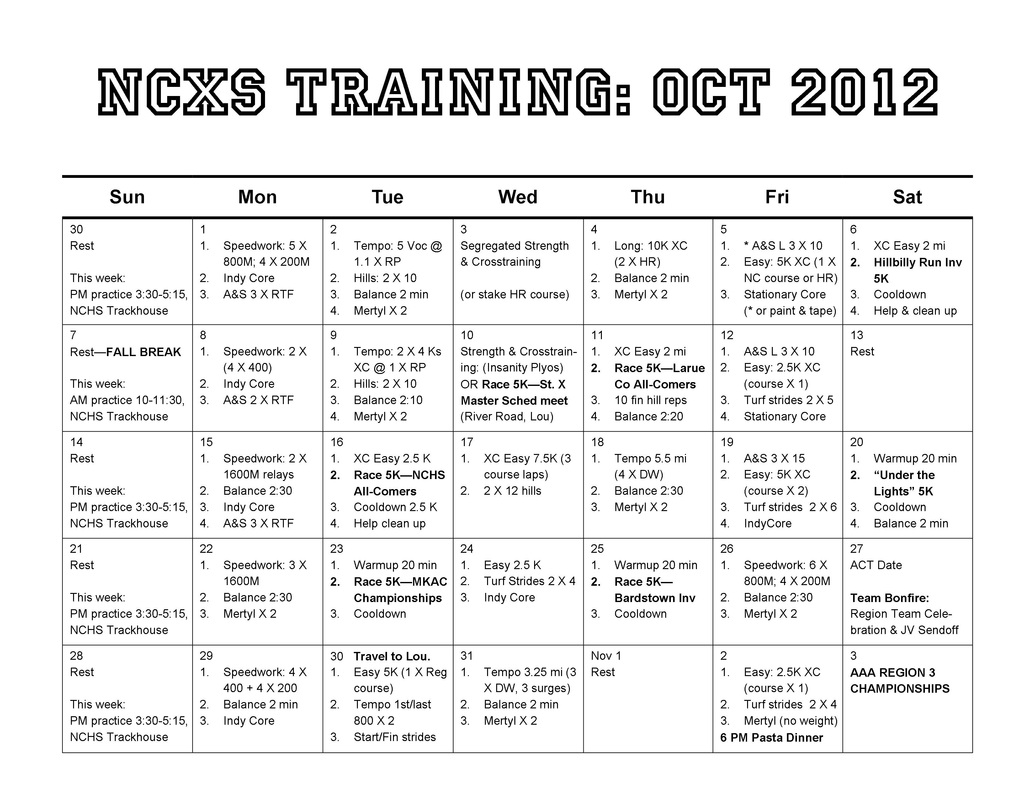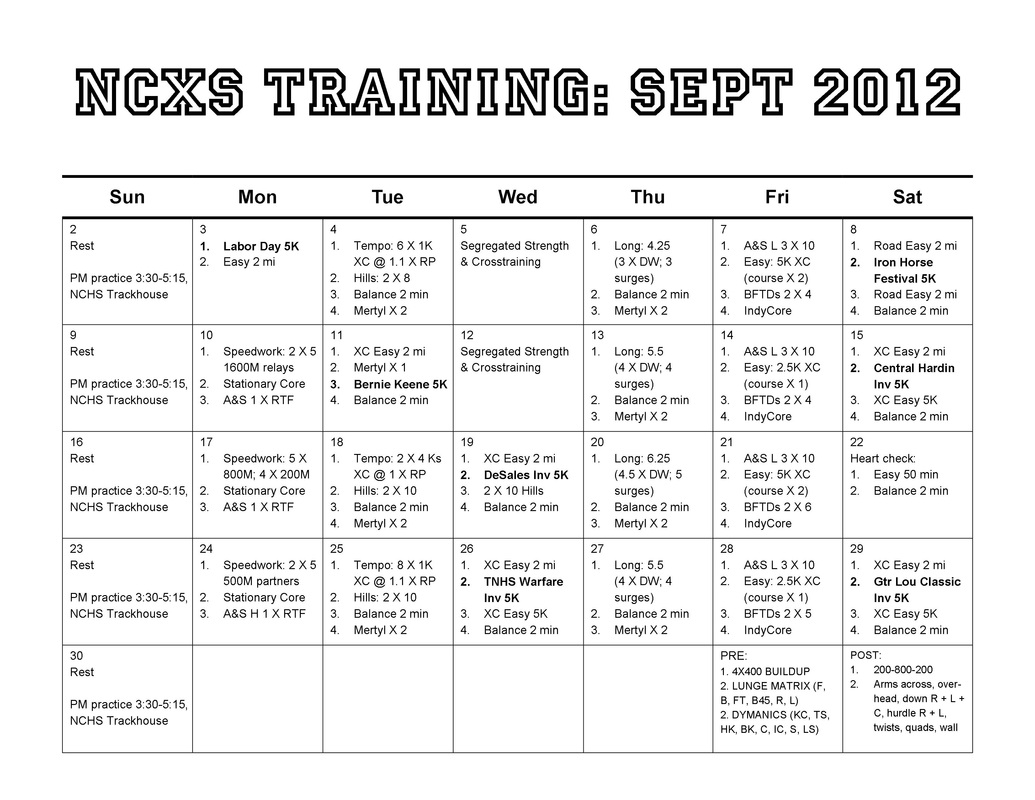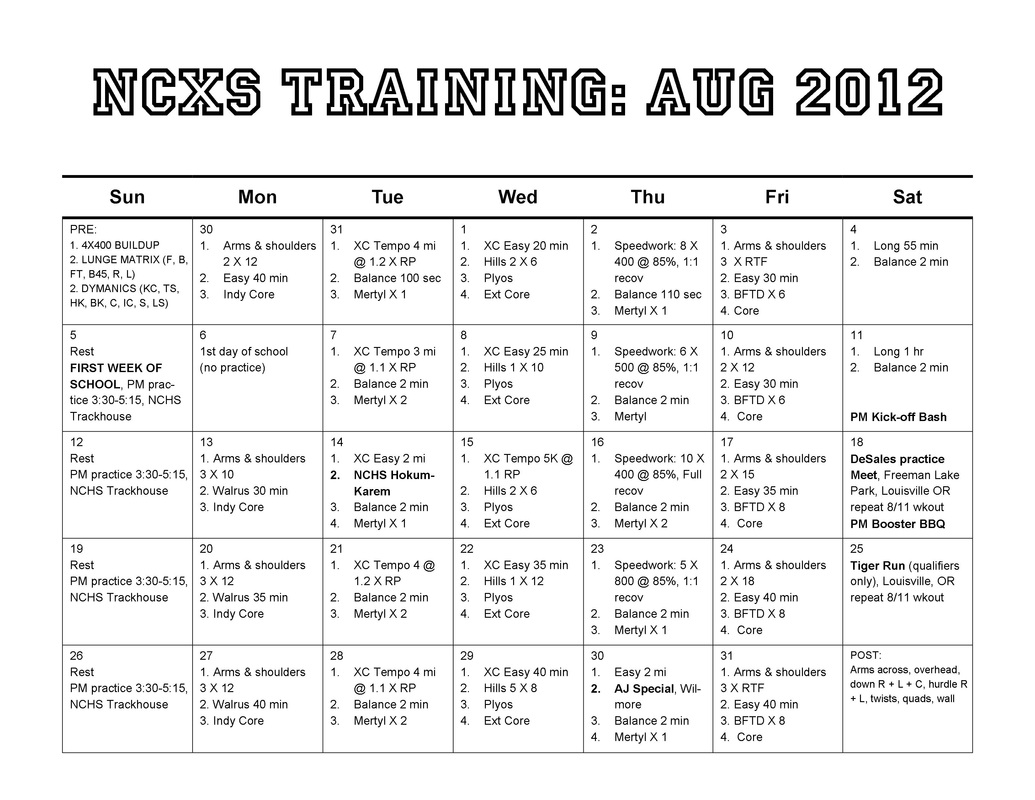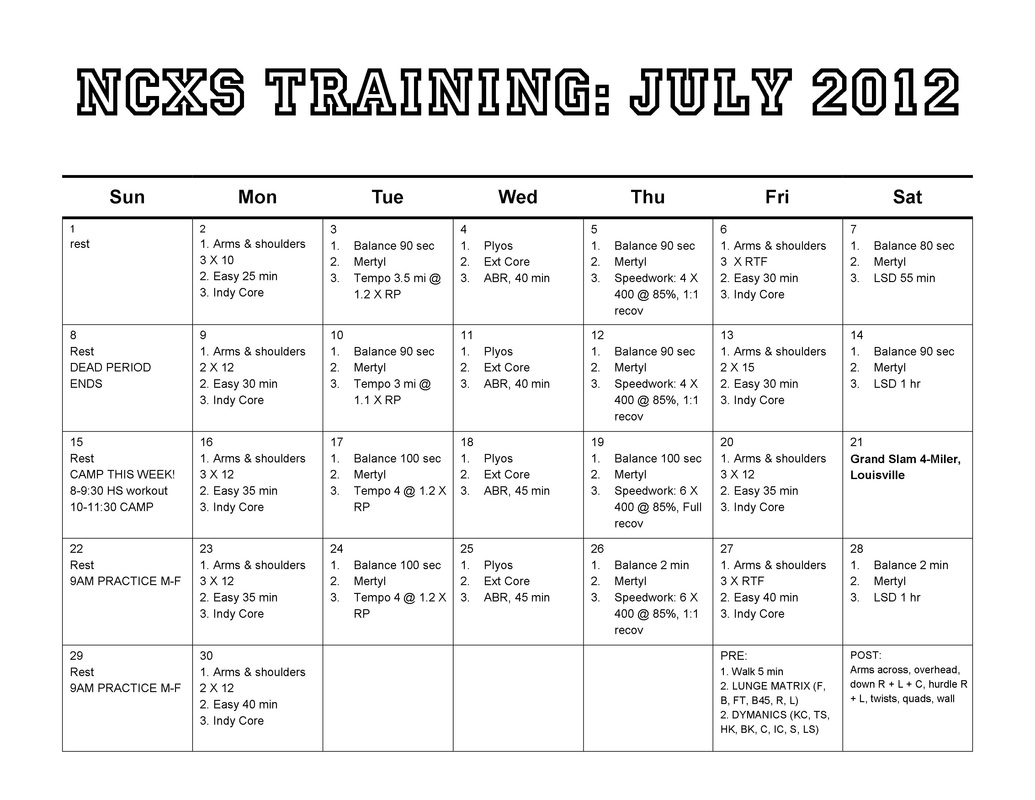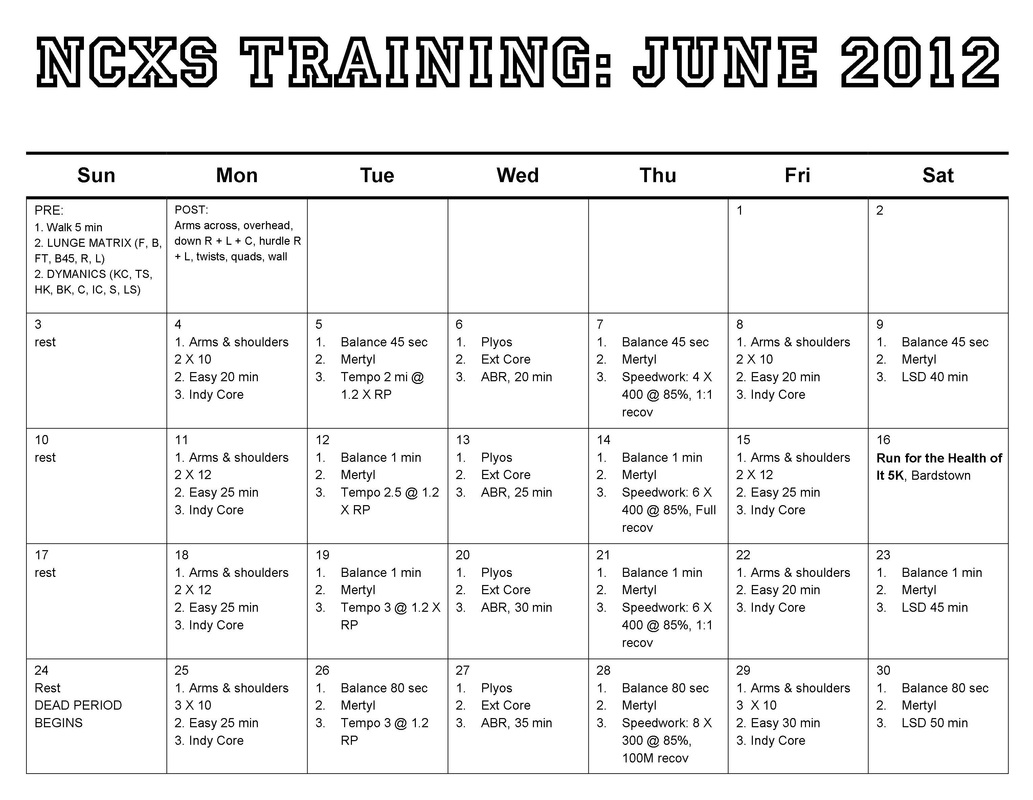Check out what's on Coach Bradley's clipboard for the all the current workout plans and advice.
"What's a plyo? And who the heck is Mertyl?" Don't understand what it means? Download the "Workout Key" below for explanantions.
CURRENT (2015) PLAN
NOTE: this is the BEGINNER PLAN ONLY. Contact Coach Bradley or Coach O'Neill if you think this is not the right plan for you.
SUMMER TRAINING PROGRAM
The intent of this program is not race specific, this is a base-building program. Following this program as closely as possible will give you a tremendous endurance base for the Fall cross-country season.
Running long and slow will train your body to run long and slow. That is why there are plenty of faster workouts sprinkled in to this program to keep you sharp. Long runs build endurance, hills build strength, speed work . . . well, speed work builds speed. The tempo and fartlek runs teach you to switch gears and run at different paces.
This program is not carved on stone tablets. Stay as close to this plan as humanly possible, and you will reap the benefits — however, if other summer activities force you to adjust, then adjust. Just keep it as true to the workout plan as you can.
Walk into and out of every run. The warm-up and cool-down are the most important aspects of injury prevention.
Stretch frequently and gently - you can pull a muscle if you over stretch it.
Sleep well and on a regular schedule — staying up 3 hours later than normal is like experiencing jet-lag when you travel across 3 time zones.
Stay hydrated. Water is your friend and companion.
Eat regular and healthy meals. Think plant-based and whole foods. If something has multiple ingredients that you cannot pronounce, that is not a whole food. An apple, melon, carrot, celery, chicken - these are whole foods. Most of your daily calories should come from fruits and vegetables; lean meats, whole grains, nuts, and legumes (beans) complement them.
Comfortable Run - This is just what it sounds like. If you are running with a training partner, you should be able to carry on a light conversation while you run. Do not allow yourself to slow to a jog - if your movement is more vertical than horizontal, that pounding can cause injury.
Run - These runs should be done a gear or two higher than the comfortable run - think comfortably hard. You are not racing, but this run is business.
Tempo Run - The first and last 1/2 mile of this run should be at a comfortable pace to ease into and out of the run. The miles in between are to be run at about 85% of your 5k race pace. This one is a gear above comfortably hard, this run is hard but sustainable.
Speed Work - I invite you to use the track facilities for these workouts, or get the distance someplace close to your home if that is easier. On speed work days, choose from one of the following work-outs with a half mile warm-up and half mile cool-down:
1. 8 x 400
2. 6 x 800
3. Pyramid: 200, 400, 600, 800, 1000, 1200, 1000, 800, 600, 400, 200
4. 12 x 300
Hills - Find a course near home that has plenty of hills. If not, go to the OKH state park amphitheater (where the Stephen Foster Story is performed). If you start at the intersection of 62 and 150, run up and around the parking lot, and then back down - that is just under 1 mile. You can repeat loops of that hill, or you can mix it up by doing the loop, then running up the hill into downtown (sidewalk is right there) and back. Bernheim has some hilly trails that you can run, as well. Stay upright when going up the hill (form will break down and you will want to bend forward at the waist --DON’T!), and pump your arms to drive you up the hill.
Fartlek Runs - These are for you to have fun with. Like the tempo runs, the first and last 1/2 mile should be at your comfortable pace to ease in and out of the run. The miles in between should be switched up by either time or landmarks. You can run 3 minutes hard followed by 2 minutes easy, and repeat that. You can choose a landmark and run hard to it, then pick another landmark to run easy to, and repeat that. The point is to switch gears on a regular basis. You can sprinkle in some 1-200m speed portions, but keep most of your segments longer (1/4 mile to 3/4 mile).
Feel free to contact me with any questions or concerns, or to get together for a run.
345president@gmail.com
(502)664-2267
Coach O’Neill
2015 SUMMER PROGRAM
I have Sundays as rest days, but adjust according to your schedule. If you get busy, remember that three runs a week will maintain fitness. The runs are listed with the mileage and the type of run. C=Comfortable, R=Run, T=Tempo, Sp=Speed, H=Hills, F=Fartlek. See the instruction sheet for explanations of each run.
June 7-13: M - 5C, T - 3R, W - 4T, Th - 3C, F - 4R Total= 19 miles
June 14-20: M - 6C, T - 3R, W - 4F, Th - 3C, F - 5R Total= 21 miles
June 21-27: M - 7C, T - 3R, W - 4H, Th - 4C, F - 5R Total= 23 miles
June 28-J4: M - 8C, T - 3C, W - 5T, Th - 4C, F - Sp Total= 25 miles
July 5-11: M - 9C, T - 3R, W - 5F, Th - 4C, F - 4T Total= 25 miles
July 12-18: Cross Country Camp
July 19-25: M - 10C, T - 3R, W - 5H, Th - 5C, F - Sp Total= 27 miles
July 26-A1: M - 11C, T - 3R, W - 6T, Th - 4C, F - 4R Total= 28 miles
The intent of this program is not race specific, this is a base-building program. Following this program as closely as possible will give you a tremendous endurance base for the Fall cross-country season.
Running long and slow will train your body to run long and slow. That is why there are plenty of faster workouts sprinkled in to this program to keep you sharp. Long runs build endurance, hills build strength, speed work . . . well, speed work builds speed. The tempo and fartlek runs teach you to switch gears and run at different paces.
This program is not carved on stone tablets. Stay as close to this plan as humanly possible, and you will reap the benefits — however, if other summer activities force you to adjust, then adjust. Just keep it as true to the workout plan as you can.
Walk into and out of every run. The warm-up and cool-down are the most important aspects of injury prevention.
Stretch frequently and gently - you can pull a muscle if you over stretch it.
Sleep well and on a regular schedule — staying up 3 hours later than normal is like experiencing jet-lag when you travel across 3 time zones.
Stay hydrated. Water is your friend and companion.
Eat regular and healthy meals. Think plant-based and whole foods. If something has multiple ingredients that you cannot pronounce, that is not a whole food. An apple, melon, carrot, celery, chicken - these are whole foods. Most of your daily calories should come from fruits and vegetables; lean meats, whole grains, nuts, and legumes (beans) complement them.
Comfortable Run - This is just what it sounds like. If you are running with a training partner, you should be able to carry on a light conversation while you run. Do not allow yourself to slow to a jog - if your movement is more vertical than horizontal, that pounding can cause injury.
Run - These runs should be done a gear or two higher than the comfortable run - think comfortably hard. You are not racing, but this run is business.
Tempo Run - The first and last 1/2 mile of this run should be at a comfortable pace to ease into and out of the run. The miles in between are to be run at about 85% of your 5k race pace. This one is a gear above comfortably hard, this run is hard but sustainable.
Speed Work - I invite you to use the track facilities for these workouts, or get the distance someplace close to your home if that is easier. On speed work days, choose from one of the following work-outs with a half mile warm-up and half mile cool-down:
1. 8 x 400
2. 6 x 800
3. Pyramid: 200, 400, 600, 800, 1000, 1200, 1000, 800, 600, 400, 200
4. 12 x 300
Hills - Find a course near home that has plenty of hills. If not, go to the OKH state park amphitheater (where the Stephen Foster Story is performed). If you start at the intersection of 62 and 150, run up and around the parking lot, and then back down - that is just under 1 mile. You can repeat loops of that hill, or you can mix it up by doing the loop, then running up the hill into downtown (sidewalk is right there) and back. Bernheim has some hilly trails that you can run, as well. Stay upright when going up the hill (form will break down and you will want to bend forward at the waist --DON’T!), and pump your arms to drive you up the hill.
Fartlek Runs - These are for you to have fun with. Like the tempo runs, the first and last 1/2 mile should be at your comfortable pace to ease in and out of the run. The miles in between should be switched up by either time or landmarks. You can run 3 minutes hard followed by 2 minutes easy, and repeat that. You can choose a landmark and run hard to it, then pick another landmark to run easy to, and repeat that. The point is to switch gears on a regular basis. You can sprinkle in some 1-200m speed portions, but keep most of your segments longer (1/4 mile to 3/4 mile).
Feel free to contact me with any questions or concerns, or to get together for a run.
345president@gmail.com
(502)664-2267
Coach O’Neill
2015 SUMMER PROGRAM
I have Sundays as rest days, but adjust according to your schedule. If you get busy, remember that three runs a week will maintain fitness. The runs are listed with the mileage and the type of run. C=Comfortable, R=Run, T=Tempo, Sp=Speed, H=Hills, F=Fartlek. See the instruction sheet for explanations of each run.
June 7-13: M - 5C, T - 3R, W - 4T, Th - 3C, F - 4R Total= 19 miles
June 14-20: M - 6C, T - 3R, W - 4F, Th - 3C, F - 5R Total= 21 miles
June 21-27: M - 7C, T - 3R, W - 4H, Th - 4C, F - 5R Total= 23 miles
June 28-J4: M - 8C, T - 3C, W - 5T, Th - 4C, F - Sp Total= 25 miles
July 5-11: M - 9C, T - 3R, W - 5F, Th - 4C, F - 4T Total= 25 miles
July 12-18: Cross Country Camp
July 19-25: M - 10C, T - 3R, W - 5H, Th - 5C, F - Sp Total= 27 miles
July 26-A1: M - 11C, T - 3R, W - 6T, Th - 4C, F - 4R Total= 28 miles
WORKOUT ARCHIVE
A great source for workout ideas and reference of past plans.
PREVIOUS SEASON PLANS FOR REFERENCE:
2013 Season Plans
2012 Season Plans
Here's the file that explains all of the above:
| |||||||
